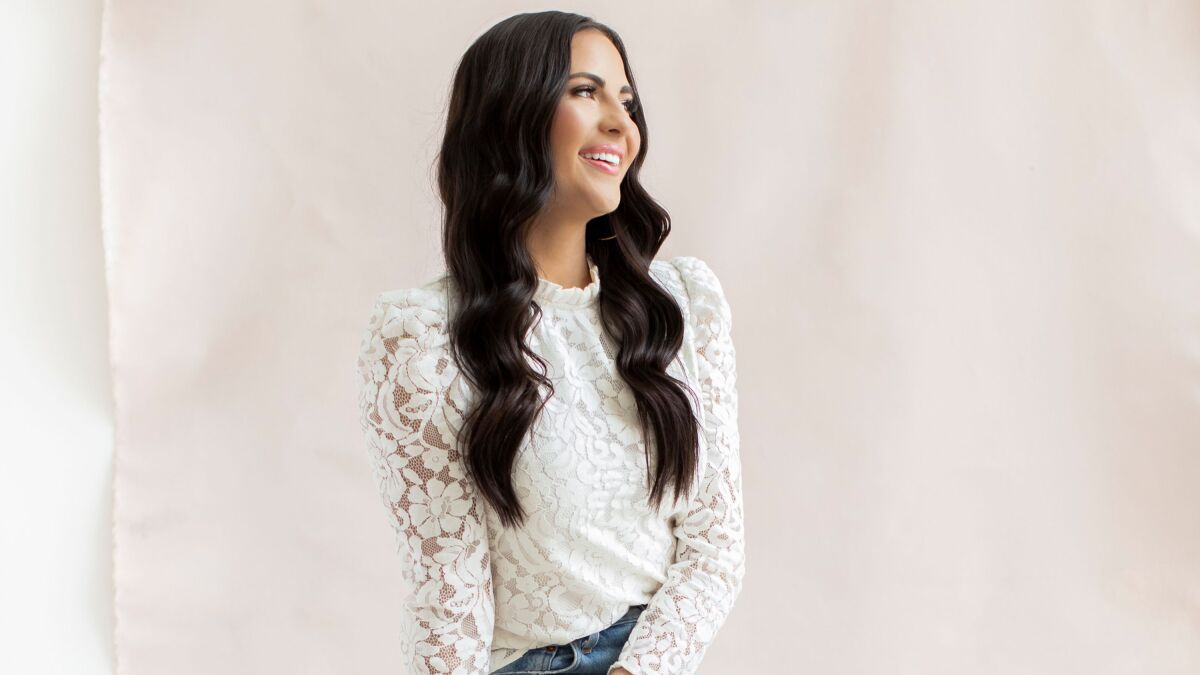Before Utah had fully realized its potential as a dynamic, robust economy, it was known as the cultural home of mommy blogging in the 2000s and 2010s. And as Utah’s economy has continued to cement itself as the top-ranked state economy for 15 years and counting, so has, well, the influence of the state’s digital content creators.
Influencers and “momfluencers” — women who commoditize their motherhood online —have long evolved past the days of mommy blogging. The global influencer market was worth more than $16 billion last year.
These highlighted, filtered influencers are not so different from the business leaders and tech founders who have come to define the state’s economy. They secure lucrative brand deals, grow successful companies and promote their own products in extremely competitive markets.
Rachel Parcell (@rachparcell), Cara Loren Van Brocklin (@caraloren), Hannah Neeleman (@BallerinaFarm) and hundreds of other women who started as bloggers and influencers have transformed themselves into moguls. And yet these influencers’ drive, technical skill sets and business sense aren’t perceived in the same way as the tech execs of Silicon Slopes, even though the timing of Utah’s tech boom and the rise of Utah’s bloggers and influencers follow the same pattern starting in the 2000s.
The old-school business leaders have something that has eluded many of the influencers-turned-moguls cohort — prestige.
Kathryn Jezer-Morton is a sociologist and writer for New York Magazine with a newsletter called “Brooding” that inspects momfluencers, online parenthood and modern family life. She spoke with me about Utah’s unique position of power in the world of online influencing.
“There’s so much money in it. If money is what makes something legitimate, it’s definitely legitimate. This is a massive economic phenomenon, and Utah is at the center. For influencing, Utah is the Rome of the Roman Empire. That’s where so many trends were born, a lot of the things that are now considered normal started there — like what it means to be a mom online.”
Jennifer Hanks is a blogger and an influencer (@cocoscaravan) who lives in Utah. Through social media, she uses her experience as a widow and mother to young twin boys to help her followers navigate grief and motherhood.
She decided to monetize her social media account and work with brands after her late husband died four years ago. “I started off slowly, but now it’s a full-time business and I get to stay home with my kids and support my family while sharing my story.”
Part of the reason why Hanks moved back to Utah was to tap into Utah’s fast-moving economy and the Silicon Slopes community. “Utah is the place to be as an influencer because of how many people start their own businesses here and are excited to make connections and collaborate.”
Meg Miles (@meg_miles) is a health and fitness influencer and owner of Wilma, a fitness training app for moms. Miles began posting on Instagram — “a place of community” — as a personal trainer before building her fitness app. Now, she markets her business on Instagram without having to take on content creation work outside of her own brand marketing.
She says, “I feel like I’m in all three worlds of Utah’s economy — tech, entrepreneurship and influencing. I’m heavily involved in the development of my app, I primarily market my business on social media, and I do some pure influencing through affiliate links as a way to organically share the things I’m loving.”
As a consumer of social media, I’ve often wondered how Utah can support so, so many successful influencers. Surely Utah’s economic environment and tech investment has assisted influencers’ thriving through the monetization of their likes and likenesses — in becoming successful CEOs behind the filters and captions. But it’s not such a logical leap to consider that Utah’s tech companies have thrived in here, in part, because of the work of the influencers.
Cydni Tetro, the co-founder and president of Utah’s Women Tech Council, told me, “When you’re building an industry or doing a specific type of work, the thing that you crave is surrounding yourself with people who give you insights, tools and techniques on the things you’re doing to build your business. As you look at the Utah landscape, you have a high concentration of influencers, technology companies and consumer companies. What’s cool about Utah is that it’s a diverse economic engine that has the ability to attract and drive these large industries so they can overlap, collaborate, and encourage growth.”
Ryan Boswell is the senior director for growth for Silicon Slopes. He says: “Influencers now, rather than pushing brands, are becoming brands. Creators are at the core of Silicon Slopes’ mission, which is supporting entrepreneurs and startups.”
He hopes Silicon Slopes can have more events targeted to content creators as part of its Marketing Chapter. “We recognize the influencer industry and it will be part of what propels Utah forward. We want to convene and connect influencers with startups to bring new innovation to new audiences moving forward.”
Some believe the tech world has been slow to embrace influencers and creatives as their own. Gabrielle Blair is an original mommy blogger at DesignMom.com who co-founded Alt Summit, a conference in its 13th year, for “women entrepreneurs, content creators and the people who want to connect with them.” She told me she believes the reason for the reticence is “patriarchy and misogyny — it’s not super complicated.”
“The tech industry really doesn’t acknowledge us or understand what we do. And then when they need us, like when they need a platform to launch from, they don’t value the work enough to pay competitively.”
Alt Summit 2023 took place in March in Palm Springs, California, and Blair tells me that Microsoft attended so conference attendees could beta-test a new product, similar to what Pinterest famously did at Alt Summit in 2010. “You can’t get more tech than Microsoft, but is the tech world going to be watching? Probably not. But marketing departments probably are.”
Seventy-seven percent of influencers who monetize their content are women and although these women own LLCs, corporations and multimillion-dollar companies, neither consumers nor industry leaders, nor sometimes even creators themselves, take them as seriously as their tech counterparts. Women have created a whole new industry — a new way of marketing and doing business made out of whole cloth — and it is still dismissed.
In her December 2022 newsletter, “Maybe We’re Too Hard on Influencers,” Jezer-Morton writes: “What if, instead of dismissing influencers categorically, we decided to understand exactly what it is that they do?”
“With every post, they have to triangulate between four competing priorities: inscrutable platform algorithms, brand partners, audience preferences and their own sense of personal ‘authenticity.’ Meanwhile, brand agreements rely on the contents’ performance, and saying something off-brand could mean losing a deal. When a family’s income is on the line, you’d better believe momfluencers are doing more than just posting cute photos.”
nfluencers are not like celebrities because part of the allure of celebrity is withholding, unlike influencers, who have attained their status through sharing their lives, or at least commoditized versions of it. It’s a vulnerable place to be when your face and persona is your company’s greatest asset. This is why the savviest of influencers diversify their platforms to create their own products, brands and companies. It shores up their influence to enter into more traditional markets and business sectors.
These more traditional business models vary as widely as capitalism will allow. For example, India Blue Severe (@indyblue_) started blogging at age 11 and by the time she was in high school, she had grown a large, loyal Instagram following. Four years ago, she and her business partner started the brand Lonely Ghost, a streetwear clothing company with a grocery store-themed brick-and-mortar store at The Riverwoods in Provo and a perfectly pithy catchphrase, “I love you say it back.”
Her oral history of “The Lonely Ghost Story” says, “We started from square one. No investors, no connections, no money. Just a lot of ideas. One thing we did have? A wild, uncontrollable, international, unexplainably powerful influence …”
She knew she had an opportunity “to create something tangible, to represent this feeling that we all shared.”
I used to have a hard time taking influencers at their words when they would talk so intimately about their “communities” or, really, their followers. As I’ve tried to take influencers more seriously, I now stand in awe of the finesse and authenticity with which they ask their followers to write a check for the “tangible” businesses they build and then promote. It takes buy-in, and followers really do buy in.
Despite the devoted followers and wealth that Utah’s influencers have continued to amass through their creativity and practically 24/7 jobs, they are still often met with side-eyed discomfort. The relationship between Utah’s influencers and its dynamic entrepreneurial world is doubly complicated because of how people view influencers generally, and sometimes also how influencers view themselves.
At the beginning of my interview with influencer Jennifer Hanks, I admitted to her that I had a difficult time getting influencers to speak with me for this story. We chatted about why that could be: “It’s nerve-wracking talking about being an influencer because you get judged — some people don’t like that you make money this way. They think it’s easy, but they don’t see the meetings and time and work that goes into a single post.”
Although influencing has been what Hanks calls “a blessing” in her life, she feels there is a stigma attached to the job. “I feel embarrassed; even the world influencer sounds silly. I say I’m a content creator or that I work in social media. I sometimes feel like I have to defend myself and justify the money I make because people don’t take it seriously.”
Like other parts of our online lives, part of the problem with the way influencing is viewed could be that we don’t know how to talk about it in an analog, nuts-and-bolts sort of way. That might be why influencers themselves don’t know how to talk about what exactly they do. They call themselves content creators or digital media marketers or they avoid labeling themselves at all and instead reference “building community.” Both of the influencers I interviewed for this story were uncomfortable with calling themselves influencers.
In her newsletter, Jezer-Morton proposes: “I wonder if our resistance to ascribing any real skill to influencing has to do with our own shame about the way we consume the content itself. So many of us (myself extremely included) feel uncomfortable with the way sharing platforms have us in a headlock, and it’s in that compromised position, awash in self-loathing at our inability to wrestle free, that we often spend our free moments scrolling.”
As we enter the second decade of influencing as we know it, there is some responsibility as consumers to understand how the sausage is made. Maybe the bad taste in your mouth after scrolling social media doesn’t come from the people who are posting, but from a lack of understanding, reflection and acknowledgment of how you got there in the first place.
To suggest that we might engage in disentangling our personal cynicisms and cultural biases so that influencers can get their due feels like a glib suggestion for a concluding thought. But taking the work that these women do seriously — their valuable skills, instincts for innovation and commitment to adapting to new technologies — there’s nothing glib about that.
Source: deseret















